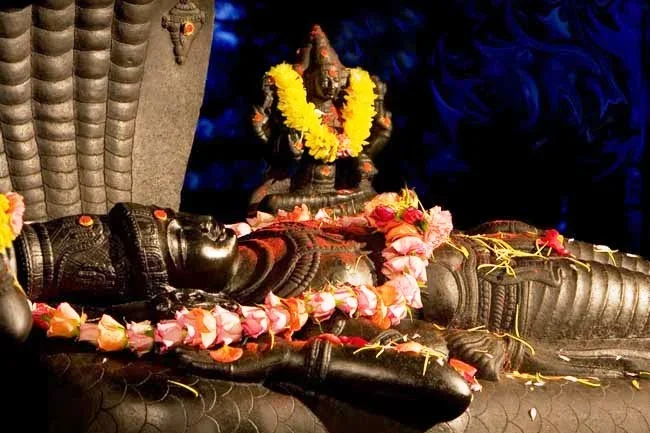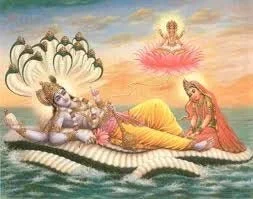Ekadasi means 'the eleventh' in Sanskrit and refers to the eleventh day of a fortnight belonging to a lunar month. Falling in the moon's waxing phase in the month of Dhanurmasa (December-January), Ekadasi is synonymous with fasting and abstinence. The Dhanurmasa sukla paksha ekadasi is called Vaikunta Ekadasi.
The austerity is associated with much deeper aspects. This is explained in the Padma Puranam (the second amongst the eighteen puranas), which tells us about the beginnings of Ekadasi with this legend. During the Krita Yuga, also termed the golden age, an asura called Muran harassed both devas and mortals. Unable to bear his tyranny, the devas sought refuge in Shiva. He directed them to approach Vishnu. Vishnu agreed to help the devas and went out to battle with Muran. During the long battle, which lasted one thousand celestial years, Vishnu needed to rest for a while. He entered a beautiful cave called Himavati in Badarikashrama to sleep. Muran wanted to strike Vishnu while he was sleeping. However, Shakti - Vishnu's female energy - emerged out of his body and assumed the form of
a beautiful damsel who fought Muran and vanquished him. When Vishnu awoke he was very pleased and named this maiden as Ekadasi and granted her a boon. The maiden said, "O Lord, if You are pleased with me and wish to give me a boon, then give me the power to deliver people from the greatest sins if they fast of this day". Vishnu granted her the boon and declared that people worshipping her would reach Vaikunta. Thus, it is said, was born the first ekadasi, which was a Dhanurmasa sukla paksha ekadasi. Sages and devout people have been since, observing the ekadasi vrata regularly. Here, the demon Muran represents the tamasic and rajasic qualities in us. The import of the ekadasi vrata is that one can conquer rajasic and tamasic tendencies in us through fasting. This helps us reach our ultimate destination, Vaikuntha, which is the place or stage of no 'kuntitha' or dullness, stupidity and misery.
It is also said that on this day the ksheerasagara manthana (churning of the ocean) took place and the nectar of immortality (amritha) was distributed to the gods. This divine event is interpreted in the following manner. The ocean of milk is the human heart filled with satvic tendencies (kindness, purity and goodness). However, in all of us there exist both types of inclinations, good (devas) and bad (asuras). Only Sadhana or the churning process will throw out the poison in us and we can procure the sweet nectar, which will liberate us from the cycle of birth and death. Shaivaites call this day as Nanjunda Ekadasi, as it was on this day Shiva consumed nanju, the poison that emanated from the churning of the ocean. Some schools of thought believe that Sri Krishna gave the
Gitopadesam to Arjuna on the day of Vaikunta Ekadasi. For the Vaishnavas,
it is a very holy day and should be ideally spent in fasting, prayer and meditation. Devotees look upon this austerity as a means to succeed in their spiritual endeavours. To them it is an activity which will increase their sankalpa (that which is beneficial to them), so as to avoid activities
which are not beneficial to them (vikalpa). Such austerities make a student of spirituality enthusiastic, positive, serene and determined. They finally lead to the understanding that all activities must be only performed for the pleasure of the Lord. Austerity is indeed one of the four legs supporting religion, the other three being purity, mercy and truthfulness.
In his Gitopadesam to Arjuna, Sri Krishna describes the threefold path of austerity and says "deva -dvija-guru-praajna-pujanam-shauchanam-arvajanam-brahmacharyam-ahimsaa-cha-shariram-tapuchyate", which means one must worship the Supreme Lord, the Brahmans, the spiritual master, and superiors like the father and mother. Cleanliness, simplicity, celibacy and nonviolence are also austerities of the body (Bhagvada Geeta 17.14). Truthful speech, which is not offensive to others and the regular
recitation of scriptures, is austerity of speech (17.15). Serenity of thought, compassion, gravity, self-control, purity of purpose, are all austerity of the mind (17.16). This threefold path of austerity, practiced by men whose aim is not to benefit materially but to please the Supreme, leads to a nature of goodness. Sri Krishna finally says that penances and austerities which are performed foolishly, by means of obstinate self-torture, or by destroying or injuring others, are the approach of the ignorant. It is also recommended that one must not perform austerities beyond his capabilities, lest the austerities become mechanical or offensive.
The Padma Purana says: "ekadasi vrata samam vrata nasti jagattraye anicchaya'pi yat krtva gatir evam vidha'vayoh ekadasi vratam ye tu bhakti bhavena kurvate na jane kim bhavet tesam vasudeva anukampaya" , which translates as: In the three worlds, there is no kind of fasting which is even comparable to the Ekadasi fast. Even if one performs this fast without a proper attitude, he achieves the Supreme Abode. If one fasts on Ekadasi day, with full devotion, what happens to him by the mercy of the Supreme Lord, I cannot say (the merit he achieves cannot be described). While Vaikunta Ekadasi is observed in all Vaishnava temples, the day is very special at the Sri Ranganatha temple at Srirangam in Tamil Nadu. On this auspicious day, Lord Ranganatha in all His glory and resplendence enters the Parama Padha Vaasal (the gateway to salvation) at the sacred precincts of the temple at Srirangam, and showers His blessings and grace on mankind.
Vaikunta Ekadashi, also known as Mukkoti Ekadasi, is observed on Margazhi Ekadashi or on the 11th day in Margali month in Tamil Nadu. Vaikunta Ekadashi 2010 date is December 17. It is a major festival in
SriRangam Sri Ranganathar temple (Ranganatha Swamy temple).
Vaikunda Ekadasi is celebrated for twenty one days which is divided to two ten days as ‘Pagal Pathu and ‘Ra Pathu. Lord Sri Ranganatha is adorned with tremendous clothes and grand golden and diamond ornaments to give Paramapada Vasal darshanam to his devotees.
Vaikunta Ekadashi vrata is observed on Dhanur Masa Shukla Paksha Ekadasi or on the 11th day of bright fortnight during Dhanur Masam. Vaikunta Ekadashi 2010 date is December 17. It falls on Margashira Shukla Ekadasi day as per Telugu and Kannada calendars. In North India, this Ekadashi is observed as Putrada Ekadasi. Vaikunta Ekadasi is a grand festival in Lord Vishnu temples. This festival is celebrated with lot of gusto in Tirumala Tirupati Sri Venkateshwara Devasthanam, Sri Rangam Ranganatha Swamy temple, Bhadrachalam Sri Rama Devasthanam, and many more Vishnu temples in South India.
On Vaikunta Ekadasi, a grand procession of Ranganatha swamy idol is held at Thirumamani Mandapam. This procession attracts lakhs of devotees
from all over India. Lord Ranganatha is attired in the form of the King known as Rangaraja. The divine text, ‘Nalayira Divya Prabandham is recited throughout the day in the temple. Bhajans are sung by devotees and the Brahmins.
Vaikunta Ekadashi is known as Putrada Ekadasi in North Indian states. Vaikunta Dwadashi, the day after Vaikunta Ekadasi, is also an auspicious day celebrated with utmost fervor and devotion in Sri Rangam Ranganathar temple. In Kerala, Vaikunta Ekadasi festival is celebrated as Swarga Vathil Ekadasi. This is the most celebrated day in Trivandrum Padmanabha Swami temple.
Compiled by
K.Raman
-------------------
This years Vaikunta Ekadasi falls on 17 Dec, 2011.

Last edited:

